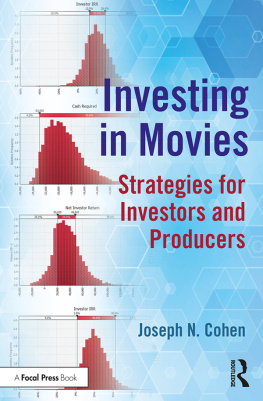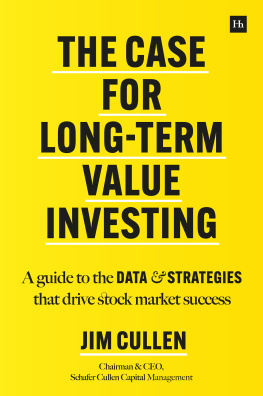Cohen - Investing in movies: strategies for producers and investors
Here you can read online Cohen - Investing in movies: strategies for producers and investors full text of the book (entire story) in english for free. Download pdf and epub, get meaning, cover and reviews about this ebook. City: New York, year: 2017, publisher: Taylor & Francis Group;Focal Press, genre: Art. Description of the work, (preface) as well as reviews are available. Best literature library LitArk.com created for fans of good reading and offers a wide selection of genres:
Romance novel
Science fiction
Adventure
Detective
Science
History
Home and family
Prose
Art
Politics
Computer
Non-fiction
Religion
Business
Children
Humor
Choose a favorite category and find really read worthwhile books. Enjoy immersion in the world of imagination, feel the emotions of the characters or learn something new for yourself, make an fascinating discovery.
Investing in movies: strategies for producers and investors: summary, description and annotation
We offer to read an annotation, description, summary or preface (depends on what the author of the book "Investing in movies: strategies for producers and investors" wrote himself). If you haven't found the necessary information about the book — write in the comments, we will try to find it.
Investing in movies: strategies for producers and investors — read online for free the complete book (whole text) full work
Below is the text of the book, divided by pages. System saving the place of the last page read, allows you to conveniently read the book "Investing in movies: strategies for producers and investors" online for free, without having to search again every time where you left off. Put a bookmark, and you can go to the page where you finished reading at any time.
Font size:
Interval:
Bookmark:
First published 2017
by Routledge
711 Third Avenue, New York, NY 10017
and by Routledge
2 Park Square, Milton Park, Abingdon, Oxon OX14 4RN
Routledge is an imprint of the Taylor & Francis Group, an informa business
2017 Taylor & Francis
The right of Joseph Cohen to be identified as the author of this Work has been asserted by him in accordance with sections 77 and 78 of the Copyright, Designs and Patents Act 1988.
All rights reserved. No part of this book may be reprinted or reproduced or utilized in any form or by any electronic, mechanical, or other means, now known or hereafter invented, including photocopying and recording, or in any information storage or retrieval system, without permission in writing from the publishers.
Trademark notice: Product or corporate names may be trademarks or registered trademarks, and are used only for identification and explanation without intent to infringe.
Library of Congress Cataloging-in-Publication Data
Names: Cohen, Joseph N. author.
Title: Investing in movies: strategies for investors and producers /
Joseph N. Cohen.
Description: New York, NY: Routledge, 2017. | Includes bibliographical
references and index.
Identifiers: LCCN 2016048952 (print) | LCCN 2017005916 (ebook) |
ISBN 9780415791908 (hardback) | ISBN 9780415791915 (pbk.) |
ISBN 9781315212159 (e-book)
Subjects: LCSH: Motion picturesProduction and direction. | Motion
picture industryFinance.
Classification: LCC PN1995.9.P7 C57 2017 (print) | LCC PN1995.9.P7
(ebook) | DDC 791.4302/32dc23
LC record available at https://lccn.loc.gov/2016048952
ISBN: 978-0-415-79190-8 (hbk)
ISBN: 978-0-415-79191-5 (pbk)
ISBN: 978-1-315-21215-9 (ebk)
Typeset in Bembo
by Apex CoVantage, LLC

New Directions
Summary Financial models for content production in new media are presented. In particular, the chapter focuses on streaming content for YouTube and other digital platforms. The potential of virtual reality and the kinds of content that are suitable for that technology are discussed, recognizing that we are still in the early stages of this technology rollout.
Probably the stupidest business decision I ever made occurred when one of my co-workers at AEI, Michael Lewis (no, not the author), approached me some 15 years ago to tell me that he wanted to leave to set up a company to develop 3-D technology for feature film projection. He left with my blessing and established RealD in 2003, which has become the dominant player in bringing 3-D technology to the screen with its digital stereoscopic projection system. I had the opportunity to be a start-up investor in RealD and join the board. But I was very busy with my core business, and besides I had doubts about the commercial prospects of 3-D technology given its failures in the past. But Michael, with his then-partner Joshua Greer, developed a much superior projection system and ease-of-use throwaway glasses, and the technology was championed by Jeffery Katzenberg, the chairman of DreamWorks Animation, whose support really put the company on the map. The company went public in 2010 with a raise of $200 million, and recently was taken private by Rizvi Traverse, the private equity firm, on a valuation of $551 million! So I clearly missed the boat. I vowed not to ignore developments in tech or new media again.
In 2014 Variety commissioned a study to see what celebrities were most admired by American teenagers. The surprising result was that the top five picks were all YouTube stars, not high-profile film and television celebrities. Smosh ranked number one, followed by the Fine Brothers, PewDie Pie, KSI and Ryan
Teenagers clearly valued the more intimate authentic experiences they enjoyed with YouTube stars whose public images are not carefully crafted by PR mavens. The Variety survey also indicated that teenagers appreciate YouTube stars more candid sense of humor, lack of filter and risk-taking spirit, characteristics that are often damped down by Hollywood handlers.
The message is clear-cut that producers who work to leverage the popularity of YouTube and other social media celebrities on multiple platforms have to be careful not to come up with matters and creative approaches that are too homogenized. My company helped structure a new digital studio, SuperGravity, which was designed to partner with top social media talent to create a broad range of entertainment, feature films, series, documentaries, stand-up comedies, etc. that could find releases on such platforms as YouTube, VIMEO, iTunes, Hulu, Netflix, Amazon Prime and other transactional and SVOD platforms. The founders of SuperGravity were pioneers in the digital space: Max Benator is the producing partner with the Fine Brothers and Marc Hustvedt was the founder of Tubefilter and the Streamy Awards, the Oscars for streaming media. He also produced the breakout digital hit Camp Takota , which was a 95-minute comedy . Camp Takotas performance on iTunes was nothing short of astounding. Released on Valentines Day 2014 and starring such YouTube celebrities as Grace Helbig, Hannah Hart and Mamrie Hart, it reached number three on iTunes independent film chart, trailing only Oscar frontrunners Twelve Years a Slave and Dallas Buyers Club. The film was made for less than $500,000 and virtually recouped before principal photography even commenced through the sale of related merchandise. The budget was designed based on projections of how many fans would preorder the film and pay for merchandise. There was virtually no marketing spend, and the film made a significant profit that, given the low budget, represented a huge ROI.
SuperGravitys first production, Man Up , staring Justin Chon (best known for portraying Eric Yorkie in the Twilight Saga film series) and Kevin Wu (the YouTube celebrity known as KevJumba), was released in May 2015 and was followed soon after by The Chosen , staring Kian Lawley (who won the Teen Choice Award for Choice YouTuber). Both films were significantly profitable on an ROI basis.
The economic model for this new area of filmmaking is still a work in progress, but it clearly offers extremely attractive potential returns, assumingand this is an important assumptionbudgets can be held in check. SuperGravity initially is focused on budgets in the $250,0001 million range, but already there are signs that some larger motion picture companies that are also trying to play in this space, like Lionsgate and Legendary, feel the need to push budgets to a $2 million ceiling. This is to counteract the negative impression that the films are lower quality from a production point of view just because they feature online talent. Also, traditional stars are starting to join the casts. Clearly the next step in the evolution of this model is to see if some of the films can warrant traditional theatrical releases.
Pressure on budgets will undoubtedly come from talents representatives. To date, talent has been prepared to regularly take fees below $100,000 in exchange for as much as 15% of the back-end. In some cases the talent pool can command as much as half of the films profits. With this caveat in mind, potential returns on films that can be made for under $1 million with high-profile YouTube celebrities are very compelling. The bulk of revenue on these projects are generated from transactional VOD. Viewers can typically download them on iTunes and Vimeo for about $10.
The SuperGravity model is predicated on hitting singles consistently, so in that sense it is very different from the feature film model we have examined in this book, which is predicated on keeping losses at a minimum and hitting the occasional home run. Even though their model was reluctantly unproven, Max and Marc completed a start-up venture capital round of capital raising with some savvy venture capital investors, led by Otter Media, a joint venture between Peter Chernin, the former president and COO of News Corp, and AT&T, and finalized a four-picture output deal with Vimeo as a first step in setting up formal working relationships with a number of major digital platformsa key objective in the companys business plan.
Next pageFont size:
Interval:
Bookmark:
Similar books «Investing in movies: strategies for producers and investors»
Look at similar books to Investing in movies: strategies for producers and investors. We have selected literature similar in name and meaning in the hope of providing readers with more options to find new, interesting, not yet read works.
Discussion, reviews of the book Investing in movies: strategies for producers and investors and just readers' own opinions. Leave your comments, write what you think about the work, its meaning or the main characters. Specify what exactly you liked and what you didn't like, and why you think so.
















